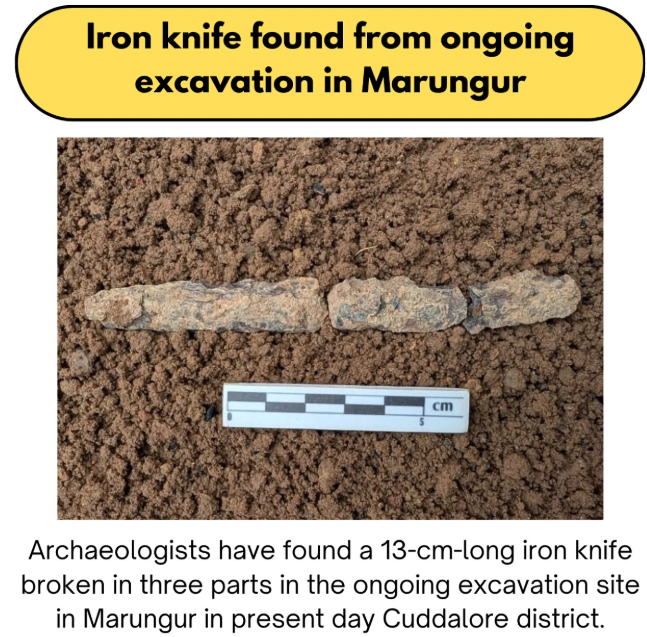PREVIOUS
Marungur Excavation 2025
July 27 , 2025
12 hrs 0 min
26
0
- The Tamil Nadu State Department of Archaeology (TNSDA) has completed the Marungur excavation in Cuddalore district.
- It was unearthing a habitation-cum-burial site dating from the Iron Age to the Early Historic Period.
- It is located between the Thenpennai and Vada Vellar rivers.
- It was part of the ancient Naduvil Mandalam.
- It is using remote-sensing techniques such as Unmanned Aerial Vehicle (UAV) mapping and LiDAR (Light Detection and Ranging) to assess various attributes of the site.
- Marungur was one of the few places in Tamil Nadu where both the habitation mound and its associated burial site were found.
- It has revealed that the habitation mound and burial site were positioned at an elevation of 100 metres above mean sea level.
- The government, on June 18, 2024, launched the archaeological excavation at Marungur from the State Secretariat.
- It was along with excavations at Keeladi and its cluster (Kondagai) in Sivagangai district; Vembakottai in Virudhunagar; Kilnamandi in Tiruvannamalai; Porpanaikottai in Pudukkottai; Tirumalapuram in Tenkasi; Sennanur in Krishnagiri; and Kongalnagaram in Tiruppur.
- It was noted that three potsherds with Tamil Brahmi inscriptions were discovered at an urn burial site in Marungur.
- This is the first time that such inscribed pots with Tamil Brahmi letters, usually placed as grave goods in urn burials, have been recovered from any archaeo- logical site in Tamil Nadu.
- One was inscribed with “a-ti-y(a)-ka-n”, and the others with “a-ma-ṉ” and “a-ta”.
- These inscribed potsherds could be dated back to the second or third century BCE, on palaeographic grounds.
- 95 items, including Tamil-Brahmi potsherds, terracotta ware, microliths, beads, bone tools, conch shells, iron implements, antimony rods, and Chola-era coins, were also found.
- Megalithic urn burials with the concentric laterite stone circles, grave goods, iron swords, and jasper beads were found.
- The Trench layers showed clear anthropogenic activity up to 6 m, revealing continuous occupation.
- Various potsherds, including the black-and-red ware, red ware, red-slipped ware, coarse red ware, rouletted ware with intricate designs, grey-rouletted ware, brown-slipped ware, and the perforated ware, were found during the excavation, indicating remarkable diversity in ceramic usage.
- They also include 12 graffiti-bearing potsherds, with some of the graffiti resembling Indus signs.
- Several burnishing tools, used to polish the surface of the pottery and terracotta wheels, were also found.
- Antimony rods were unearthed, their blunt edges indicating that they were used for ornamental purposes.
- A medieval copper coin from the period of Raja Raja Chola I was also unearthed from the top layers.
- From the same stratigraphic layer, charcoal samples were retrieved, offering an opportunity for radiocarbon dating and further contextual analysis.
- Two inner cores of conch shells, one of which measured 7 cm in length, were unearthed at a depth of 3.6 metres.
- A 13-cm-long iron knife, broken into three pieces, weighing 22.97 grams and measuring 2.8 mm in thickness, was also recovered from a depth of 2.57 metres.
- At the burial site located in a cashew grove, the archaeologists dug two trenches.
- During excavation, two laterite stone circles were identified, confirming the presence of megalithic burials.
- The first megalithic structure revealed a laterite stone circle with a diameter of eight metres.
- The surface of the circle was covered with small laterite stones.
- It revealed two concentric stone circles.
- They were the inner circle composed of medium-sized laterite stones and the outer structure of larger stones.
- The stone circle was divided into four quadrants for methodical excavation.
- Initial layers yielded hard laterite stone.
- At the centre, a large capstone was found, placed to protect the burial urn beneath.
- The urn itself was placed within a laterite bedrock cavity.
- In the second megalithic burial area, beneath the laterite layers, a fine red soil stratum was encountered.
- From that, eight urns made of the red ware were exposed at varying levels and in different sizes.
- Iron swords were also found outside two of the urns, while other iron objects were recovered from inside the urns.
- In both the trenches, offering pots around the urns were recovered.
- These included black-and-red ware, red-slipped ware, black-slipped ware, and plain red ware pots.
- The charcoal samples will be sent to the Beta Analytic laboratory in Florida, U.S., for Accelerator Mass Spectrometry analysis for dating.
- While the pollen samples collected will be sent to the French Institute of Pondicherry.
- Further, archaeo-botanical investigations, phytolith and petrology analyses, and Optically Stimulated Luminescence and Thermoluminescence dating will be employed to determine the exposure of sediments and ceramics to heat or light.
- The University of Madras had already conducted excavations near Marungur, at Karaikadu and Kudikadu.
- This site also holds significance as it is located close to the ancient port cities of Arikamedu in the Union Territory of Puducherry and Poompuhar in the Mayiladuthurai district.
- The TNSDA has also mooted preliminary surveys at Manikkollai, nearly 30 km from Marungur, for conducting excavations during 2025-26.

Leave a Reply
Your Comment is awaiting moderation.


